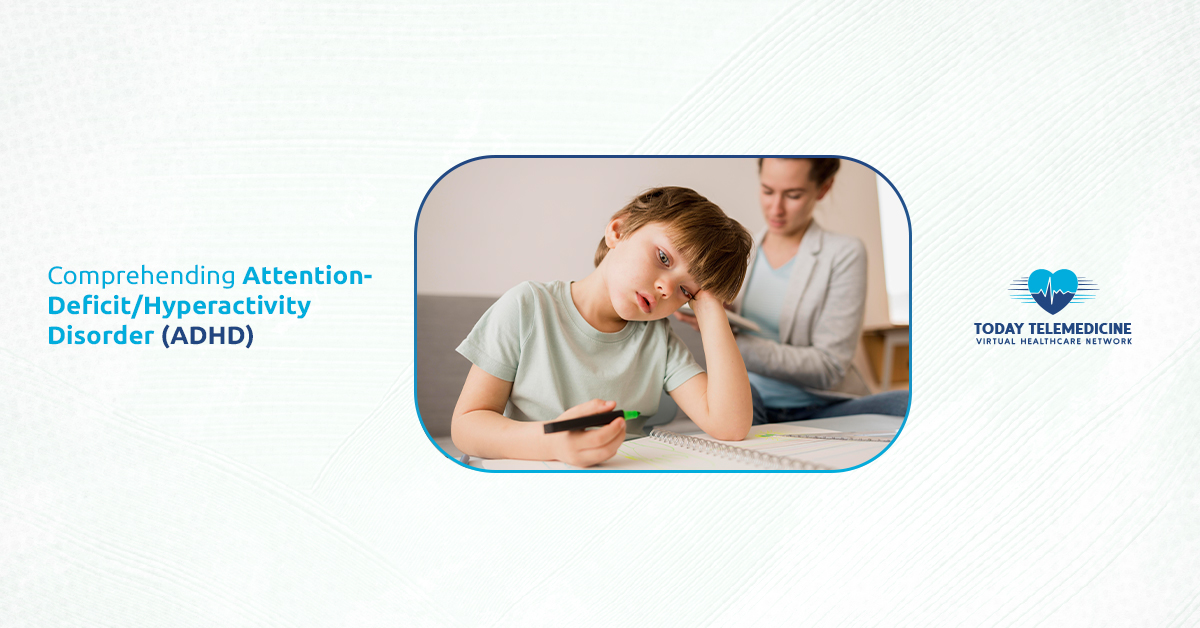Attention-Deficit/Hyperactivity Disorder (ADHD) is a neurodevelopmental disorder usually identified in childhood, presenting in diverse manifestations. There is probably a genetic predisposition to developing ADHD, but things like stress and conflict in the environment can make it worse.
Inattention, hyperactivity, and impulsivity are the main signs of ADHD. Daydreaming, trouble staying focused, and being easily distracted are all signs of attention problems. Fidgeting or being restless is a sign of hyperactivity. A person with ADHD may be impulsive or disruptive, have trouble getting along with others, and be more likely to get hurt. Hyperactivity and impulsivity frequently decrease with age, whereas attention difficulties often endure into adulthood.
ADHD is the most common condition seen in outpatient mental health services for children and teens. It is thought to affect more than 5% of kids. ADHD is diagnosed in males roughly twice as frequently as in females.
The disorder can last into adulthood, but hyperactivity is less common then. Adults with ADHD often have trouble remembering things, focusing, staying organized, and keeping their promises at work or home. These functional impairments can cause other problems, like anxiety, low self-esteem, or mood disorders. Some people may use drugs or alcohol to deal with these problems.
Important Signs of ADHD
Inattention, hyperactivity, and impulsive behavior are common signs of ADHD, and they are often first noticed in school. A teacher might say that a child isn’t paying attention, is “hyper,” or is causing problems. A child with ADHD may want to do well in school, but their symptoms can make it hard for them to do so. Teachers, parents, and peers might think these actions are bad on purpose.
A high energy level and occasional impulsivity are normal in kids, but the hyperactivity that comes with ADHD is usually more chaotic and doesn’t have a clear goal. For kids with ADHD, these behaviors are bad enough to make learning, making friends, and staying safe very hard.
The symptoms of ADHD can be very different from one person to the next. The common traits are grouped into two main groups: inattention and hyperactivity/impulsivity.
Symptoms of being inattentive
- Making mistakes without thinking.
- It’s challenging to keep your attention over time.
- Not seeming to listen when someone talks to them directly.
- Not following through on what teachers or parents tell you to do.
- Having trouble keeping track of tasks and activities.
- Not doing things that require a lot of mental effort.
- Losing things you need to do things or activities.
- Being easily distracted by things outside of yourself.
- Not remembering things you do every day.
Symptoms of hyperactivity and impulsiveness
- Too much fidgeting or moving around.
- Not being able to stay seated when you should.
- Running or climbing in the wrong way.
- Not being able to do quiet things for fun.
- Always “on the go” or driven behavior.
- Too much talking.
- Doing things without thinking, like acting on impulse.
- A lot of the time, I blurt out answers in class.
- Having trouble waiting for your turn in a group.
- Constantly interrupting or bothering other people.
A lot of kids with ADHD also have signs of other behavioral or mental health problems. These could be different ways that the same biological or environmental factors are showing up. Some of these conditions that happen at the same time are learning disabilities and behavior disorders that cause problems.
Learning Disabilities: As many as 25% of kids with ADHD may also have a learning disability. This is a lot more than the general population.
Oppositional, Defiant, or Conduct Disorders: These behavior disorders, which are marked by frequent, very negative, angry, or aggressive behavior, affect up to half of all kids with ADHD. The simultaneous presence of ADHD and these disorders correlates with a diminished long-term prognosis, encompassing elevated rates of academic failure, antisocial behavior, and substance abuse.
The Process of Diagnosing ADHD
No one test can definitely tell if someone has ADHD. A pediatrician may make the diagnosis for a child or send them to a specialist. Parents or teachers who notice possible symptoms often start the evaluation process. A mental health professional usually assesses adults.
The doctor will ask about ADHD symptoms and, for kids, how they act in school. To get all the information they need, evaluators often talk to parents, teachers, and other caregivers, or they use standardized behavioral checklists.
A comprehensive medical history and physical examination are essential to exclude alternative conditions that may present with symptoms resembling ADHD, including auditory or visual impairments, learning disabilities, speech disorders, seizure disorders, anxiety, or depression. To find out if someone has these conditions and to make a full treatment plan, they may need more medical or psychological tests.
Expected Length of Time and Prognosis
Most kids with ADHD show signs of the disorder before they turn 12 and keep having them into their teenage years. Some people may notice that their symptoms get better as they get older, but for many, ADHD is a lifelong condition that doesn’t go away when they become adults. If the condition is diagnosed early and treated correctly, it can be managed well, which lets people live productive and successful lives.
Things that make ADHD more likely
We don’t fully understand what causes ADHD, but there are a few things that are linked to its development. Taking care of these risk factors may help lower the chance of getting the disorder.
Common risk Factors
- Temperament: Characteristics including novelty-seeking, negative emotionality, and inadequate impulse control.
- Psychosocial adversity includes things like child abuse or neglect, serious problems in a marriage, a father who is a criminal, a mother with mental health problems, poverty, or being placed in foster care.
- Pregnancy and Delivery Complications: These include the mother’s poor health, the baby’s distress, and a low birth weight.
- Birth too soon.
- Substance Use by the Mother: This includes using tobacco, alcohol, or other drugs while pregnant.
- Exposure to neurotoxins, like lead.
- Family History: A close relative has had ADHD in the past.
Strategies for Treating ADHD
There is no cure for ADHD, but there are many treatments that work well. The main goals of treatment are to make social interactions better, boost academic performance, and cut down on bad or disruptive behaviors. The best results usually come from a mix of medication and therapy.
Drugs
For decades, stimulant medications like methylphenidate and amphetamine formulations have been used to help people focus and control their behavior. These medications are generally safe and effective. For kids, long-acting forms are often better.
Stimulants help with hyperactivity and impulsivity when ADHD is diagnosed correctly, even though they are classified as such. You can often manage common side effects like loss of appetite and trouble sleeping by changing the dose. You need to talk to a doctor about the risks, such as how they could affect growth, heart health, and the chance of misuse or diversion.
There are also non-stimulant drugs like atomoxetine, viloxazine, bupropion, guanfacine, and clonidine that may work just as well.
Interventions for Therapy and Behavior
- Behavioral therapy is based on setting clear expectations and consequences to encourage good behaviors and discourage bad ones.
- Cognitive therapy tries to change negative thought patterns, boost self-esteem, and make it easier to solve problems.
- Social skills training helps people learn how to make friends and get along better with others.
- Parent Education and Support: Helps parents learn how to deal with ADHD-related behaviors and gives them the tools they need to do so.
- Schools may use an Individualized Education Plan (IEP) or other methods to make the learning environment more supportive.
When to Get Help from a Professional
If your child shows signs of ADHD or if teachers say they are having trouble in school, acting out, or paying attention, see a doctor. To effectively manage the condition, early and appropriate intervention is essential.





